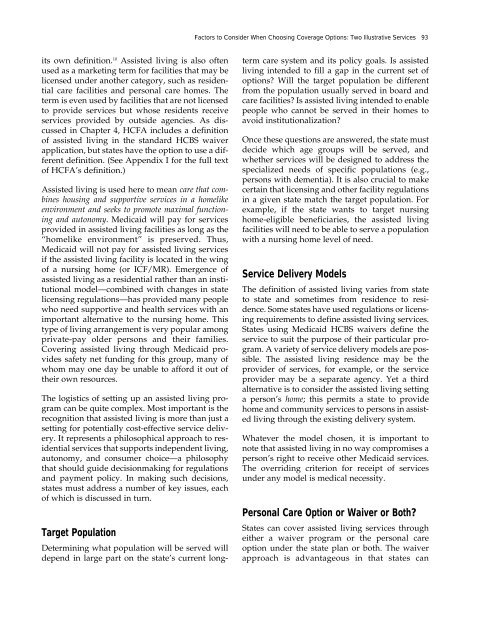Full PDF Version - ASPE - U.S. Department of Health and Human ...
Full PDF Version - ASPE - U.S. Department of Health and Human ...
Full PDF Version - ASPE - U.S. Department of Health and Human ...
- No tags were found...
You also want an ePaper? Increase the reach of your titles
YUMPU automatically turns print PDFs into web optimized ePapers that Google loves.
Factors to Consider When Choosing Coverage Options: Two Illustrative Services 93its own definition. 10 Assisted living is also <strong>of</strong>tenused as a marketing term for facilities that may belicensed under another category, such as residentialcare facilities <strong>and</strong> personal care homes. Theterm is even used by facilities that are not licensedto provide services but whose residents receiveservices provided by outside agencies. As discussedin Chapter 4, HCFA includes a definition<strong>of</strong> assisted living in the st<strong>and</strong>ard HCBS waiverapplication, but states have the option to use a differentdefinition. (See Appendix I for the full text<strong>of</strong> HCFA’s definition.)Assisted living is used here to mean care that combineshousing <strong>and</strong> supportive services in a homelikeenvironment <strong>and</strong> seeks to promote maximal functioning<strong>and</strong> autonomy. Medicaid will pay for servicesprovided in assisted living facilities as long as the“homelike environment” is preserved. Thus,Medicaid will not pay for assisted living servicesif the assisted living facility is located in the wing<strong>of</strong> a nursing home (or ICF/MR). Emergence <strong>of</strong>assisted living as a residential rather than an institutionalmodel—combined with changes in statelicensing regulations—has provided many peoplewho need supportive <strong>and</strong> health services with animportant alternative to the nursing home. Thistype <strong>of</strong> living arrangement is very popular amongprivate-pay older persons <strong>and</strong> their families.Covering assisted living through Medicaid providessafety net funding for this group, many <strong>of</strong>whom may one day be unable to afford it out <strong>of</strong>their own resources.The logistics <strong>of</strong> setting up an assisted living programcan be quite complex. Most important is therecognition that assisted living is more than just asetting for potentially cost-effective service delivery.It represents a philosophical approach to residentialservices that supports independent living,autonomy, <strong>and</strong> consumer choice—a philosophythat should guide decisionmaking for regulations<strong>and</strong> payment policy. In making such decisions,states must address a number <strong>of</strong> key issues, each<strong>of</strong> which is discussed in turn.Target PopulationDetermining what population will be served willdepend in large part on the state’s current longtermcare system <strong>and</strong> its policy goals. Is assistedliving intended to fill a gap in the current set <strong>of</strong>options? Will the target population be differentfrom the population usually served in board <strong>and</strong>care facilities? Is assisted living intended to enablepeople who cannot be served in their homes toavoid institutionalization?Once these questions are answered, the state mustdecide which age groups will be served, <strong>and</strong>whether services will be designed to address thespecialized needs <strong>of</strong> specific populations (e.g.,persons with dementia). It is also crucial to makecertain that licensing <strong>and</strong> other facility regulationsin a given state match the target population. Forexample, if the state wants to target nursinghome-eligible beneficiaries, the assisted livingfacilities will need to be able to serve a populationwith a nursing home level <strong>of</strong> need.Service Delivery ModelsThe definition <strong>of</strong> assisted living varies from stateto state <strong>and</strong> sometimes from residence to residence.Some states have used regulations or licensingrequirements to define assisted living services.States using Medicaid HCBS waivers define theservice to suit the purpose <strong>of</strong> their particular program.A variety <strong>of</strong> service delivery models are possible.The assisted living residence may be theprovider <strong>of</strong> services, for example, or the serviceprovider may be a separate agency. Yet a thirdalternative is to consider the assisted living settinga person’s home; this permits a state to providehome <strong>and</strong> community services to persons in assistedliving through the existing delivery system.Whatever the model chosen, it is important tonote that assisted living in no way compromises aperson’s right to receive other Medicaid services.The overriding criterion for receipt <strong>of</strong> servicesunder any model is medical necessity.Personal Care Option or Waiver or Both?States can cover assisted living services througheither a waiver program or the personal careoption under the state plan or both. The waiverapproach is advantageous in that states can
















